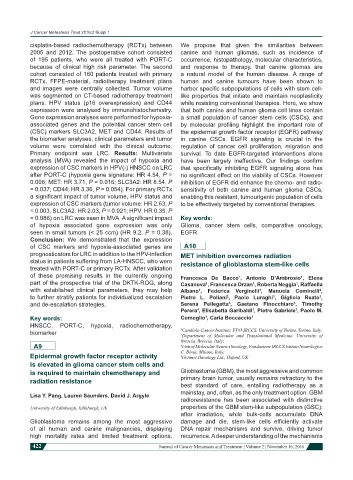Page 432 - Read Online
P. 432
J Cancer Metastasis Treat 2016;2 Suppl 1
cisplatin-based radiochemotherapy (RCTx) between We propose that given the similarities between
2005 and 2012. The postoperative cohort consisted canine and human gliomas, such as incidence of
of 195 patients, who were all treated with PORT-C occurrence, histopathology, molecular characteristics,
because of clinical high risk parameter. The second and response to therapy, that canine gliomas are
cohort consisted of 160 patients treated with primary a natural model of the human disease. A range of
RCTx. FFPE-material, radiotherapy treatment plans human and canine tumours have been shown to
and images were centrally collected. Tumor volume harbor specific subpopulations of cells with stem cell-
was segmented on CT-based radiotherapy treatment like properties that initiate and maintain neoplasticity
plans. HPV status (p16 overexpression) and CD44 while resisting conventional therapies. Here, we show
expression were analysed by immunohistochemistry. that both canine and human glioma cell lines contain
Gene expression analyses were performed for hypoxia- a small population of cancer stem cells (CSCs), and
associated genes and the potential cancer stem cell by molecular profiling highlight the important role of
(CSC) markers SLC3A2, MET and CD44. Results of the epidermal growth factor receptor (EGFR) pathway
the biomarker analyses, clinical parameters and tumor in canine CSCs. EGFR signaling is crucial in the
volume were correlated with the clinical outcome. regulation of cancer cell proliferation, migration and
Primary endpoint was LRC. Results: Multivariate survival. To date EGFR-targeted interventions alone
analysis (MVA) revealed the impact of hypoxia and have been largely ineffective. Our findings confirm
expression of CSC markers in HPV(-) HNSCC on LRC that specifically inhibiting EGFR signaling alone has
after PORT-C (hypoxia gene signature: HR 4.54, P = no significant effect on the viability of CSCs. However
0.006; MET: HR 3.71, P = 0.016; SLC3A2: HR 8.54, P inhibition of EGFR did enhance the chemo- and radio-
= 0.037; CD44: HR 3.36, P = 0.054). For primary RCTx sensitivity of both canine and human glioma CSCs,
a significant impact of tumor volume, HPV status and enabling this resistant, tumourigenic population of cells
expression of CSC markers (tumor volume: HR 2.63, P to be effectively targeted by conventional therapies.
= 0.003, SLC3A2: HR 2.03, P = 0.021; HPV: HR 0.35, P
= 0.086) on LRC was seen in MVA. A significant impact Key words:
of hypoxia associated gene expression was only Glioma, cancer stem cells, comparative oncology,
seen in small tumors (< 25 ccm) (HR 9.2, P = 0.38). EGFR
Conclusion: We demonstrated that the expression
of CSC markers and hypoxia-associated genes are A10
prognosticators for LRC in addition to the HPV-infection MET inhibition overcomes radiation
status in patients suffering from LA-HNSCC, who were resistance of glioblastoma stem-like cells
treated with PORT-C or primary RCTx. After validation
of these promising results in the currently ongoing Francesca De Bacco , Antonio D’Ambrosio , Elena
1
1
part of the prospective trial of the DKTK-ROG, along Casanova , Francesca Orzan , Roberta Neggia , Raffaella
1
1
1
with established clinical parameters, they may help Albano , Federica Verginelli , Manuela Cominelli ,
1
1
2
to further stratify patients for individualized escalation Pietro L. Poliani , Paolo Luraghi , Gigliola Reato ,
1
1
2
3
3
and de-escalation strategies. Serena Pellegatta , Gaetano Finocchiaro , Timothy
Perera , Elisabetta Garibaldi , Pietro Gabriele , Paolo M.
4
1
1
Key words: Comoglio , Carla Boccaccio 1
1
HNSCC, PORT-C, hypoxia, radiochemotherapy,
biomarker 1 2 Candiolo Cancer Institute, FPO-IRCCS, University of Torino, Torino, Italy;
Department of Molecular and Translational Medicine, University of
Brescia, Brescia, Italy;
A9 3 Unit of Molecular Neuro-Oncology, Fondazione IRCCS Istituto Neurologico
Epidermal growth factor receptor activity C. Besta, Milano, Italy;
Octimet Oncology Ltd., Oxford, UK
4
is elevated in glioma cancer stem cells and
is required to maintain chemotherapy and Glioblastoma (GBM), the most aggressive and common
radiation resistance primary brain tumor, usually remains refractory to the
best standard of care, entailing radiotherapy as a
mainstay, and, often, as the only treatment option. GBM
Lisa Y. Pang, Lauren Saunders, David J. Argyle
radioresistance has been associated with distinctive
University of Edinburgh, Edinburgh, UK properties of the GBM stem-like subpopulation (GSC):
after irradiation, while bulk-cells accumulate DNA
Glioblastoma remains among the most aggressive damage and die, stem-like cells efficiently activate
of all human and canine malignancies, displaying DNA repair mechanisms and survive, driving tumor
high mortality rates and limited treatment options. recurrence. A deeper understanding of the mechanisms
422
Journal of Cancer Metastasis and Treatment ¦ Volume 2 ¦ November 16, 2016

